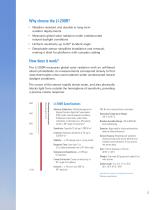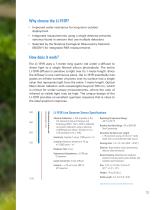
Catalog excerpts

Light Measurement The Standard for over 50 Years
Open the catalog to page 1
Introduction LI-COR radiation sensors measure the flux of radiant energy—the energy that drives plant growth, warms the earth, and lights our world. The properties of radiant flux depend on the wavelength of the radiation. Pyranometers are sensitive to the broadest waveband. Photometric sensors measure visible radiation (light). Quantum sensors measure Photosynthetically Active Radiation (PAR)—the radiant energy used in photosynthesis. These three sensor types cover a wide range of applications: plant research indoor lighting Photometric Sensor (Visible Light) Quantum Sensor...
Open the catalog to page 2
The Sensors LI-COR sensors are weather resistant, low maintenance, and cosine corrected. From the shape of the crown to the photodiodes and optical filter glass, every aspect is the result of scientific inquiry. The sensor design features a large drain to shed water, and a more robust housing to help prevent water ingress, increasing the lifespan of the sensors and reducing measurement drift. A detachable sensor head allows for replacement and factory recalibration without removing the cable from the mounting structure. Water shedding design Interchangeable heads Detachable base Multiple...
Open the catalog to page 3
LI-200R Pyranometer The LI-200R Pyranometer is meant to be used outdoors under unobstructed natural daylight conditions. It measures global solar radiation— the combination of direct and diffuse solar radiation—in the 400 to 1100 nm range. Measurement units are in watts per square meter (W m-2). Ideal for agricultural, meteorological, solar energy, and environmental research, the LI-200R is available with a variety of cable lengths and output signals for compatibility with most data loggers
Open the catalog to page 4
Why choose the LI-200R? • Weather resistant and durable in long-term outdoor deployments • Measures global solar radiation under unobstructed natural daylight conditions • Uniform sensitivity up to 82° incident angle • Detachable sensor simplifies installation and removal, making it ideal for platforms with complex cabling How does it work? The LI-200R measures global solar radiation with an unfiltered silicon photodiode. Its measurements correspond closely to firstclass thermopiles when used outdoors under unobstructed natural daylight conditions. The crown of the sensor rapidly sheds...
Open the catalog to page 5
The LI-190R measures Photosynthetically Active Radiation (PAR, in µmol of photons m-2 s-1). It provides accurate measurements—in the open, in greenhouses, under plant canopies, or in growth chambers—for most broad-spectrum light sources, including natural sunlight, artificial, or mixed sources. Plants use light in the wavelength range from about 400 to 700 nm to drive photosynthesis. The efficiency with which plants use light varies somewhat across this range, but McCree1 showed that measuring PAR provided a consistent way to predict plant photosynthetic response regardless of the spectrum...
Open the catalog to page 6
The LI-190R quantum response and the ideal quantum response curve in energy units (top) and photon units (bottom). Waveband measured Wavelength (nm) LI-190R Specifications Absolute Calibration: ± 5% traceable to the U.S. National Institute of Standards and Technology (NIST) Sensitivity: Typically 5 μA to 10 μA per 1,000 μmol s-1 m-2 Linearity: Maximum deviation of 1% up to 10,000 μmol s-1 m-2 Ideal Quantum Response Relative Response (%) A high-quality silicon photodiode is matched with a specially designed glass optical filter to create nearly uniform sensitivity to all the wavelengths...
Open the catalog to page 7
LI-210R Photometric Sensor The LI-210R Photometric Sensor measures light with the same sensitivity as a typical human eye. The photometric sensor is ideal for evaluating illumination in work areas, exhibits, interior lighting, and in public spaces. Measurement units are lux or klux.
Open the catalog to page 8
Why choose the LI-210R? • Spectral response closely matches the CIE Standard Observer Curve • Excellent cosine response—sensitive to light from all directions up to an 82˚ angle of incidence • Detachable sensor simplifies installation and removal, making it ideal for platforms with complex cabling How does it work? The LI-210R measures light with a precision filtered silicon photodiode that is sensitive to light in the visible spectrum. 1.0 Relative Response Typical spectral response of the LI-210R Photometric Sensor. Waveband measured Wavelength (nm) LI-210R Specifications Absolute...
Open the catalog to page 9
LI-191R Line Quantum Sensor The LI-191R Line Quantum Sensor measures PAR integrated over its 1-meter length. It is used to measure sunlight under a plant canopy, where the light field is non-uniform. The LI-191R makes it easy to measure under-canopy light in many plots quickly and consistently. It measures light in units of Photosynthetic Photon Flux Density (PPFD), which is expressed as µmol s-1 m-2.
Open the catalog to page 10
Why choose the LI-191R? • Improved water resistance for long-term outdoor deployment • Integrated measurements using a single detector prevents variance found in sensors that use multiple detectors • Selected by the National Ecological Observatory Network (NEON®) for integrated PAR measurements How does it work? The LI-191R uses a 1-meter long quartz rod under a diffuser to direct light to a single filtered silicon photodiode. The entire LI-191R diffuser is sensitive to light over its 1-meter length. Since the diffuser is one continuous piece, the LI-191R essentially integrates an infinite...
Open the catalog to page 11
LI-192 Underwater Quantum Sensor The LI-192 Underwater Quantum Sensor measures PAR from all angles in one hemisphere. The LI-192 works in air or underwater at depths up to 560 meters. The measurements are cosine corrected and typically expressed as Photosynthetic Photon Flux Density (PPFD). For simultaneous measurements of downwelling and upwelling PAR, two sensors can be mounted on the 2009S Lowering Frame.
Open the catalog to page 12
Why choose the LI-192? • Designed for immersion • Rugged, corrosion-resistant sensors for use in fresh and saltwater environments • Ideal for oceanography, limnology, turbidity, and vertical profiling • Suitable for submerged and out-of-water measurements How does it work? The LI-192 uses a silicon photodiode and a glass optical filter to create nearly uniform sensitivity to light between 400 and 700 nm, which closely corresponds to light used by most terrestrial and aquatic plants and algae. A precision optical filter blocks light with wavelengths beyond 700 nm, which is critical for...
Open the catalog to page 13
